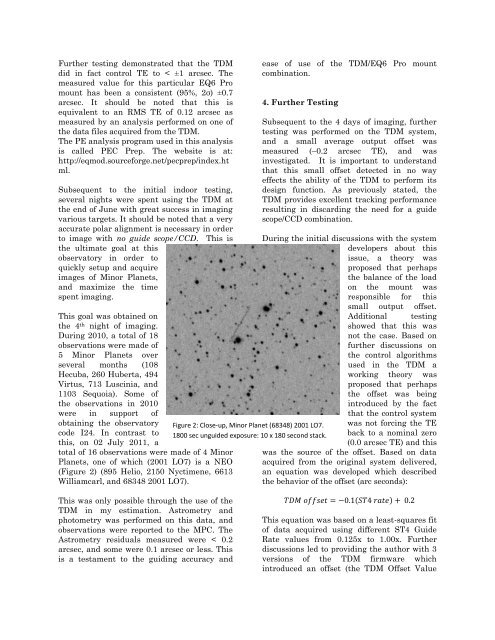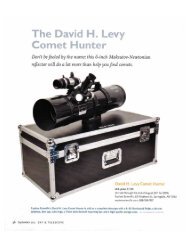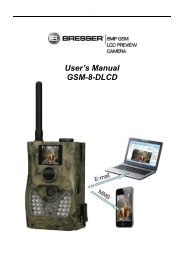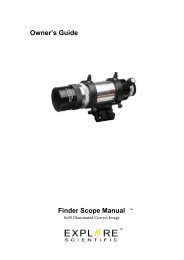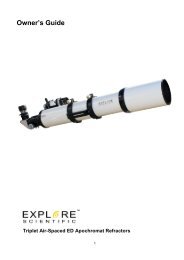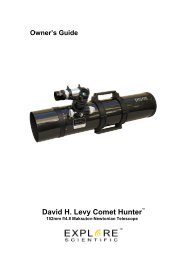An Investigation into the Operation and Control ... - Explore Scientific
An Investigation into the Operation and Control ... - Explore Scientific
An Investigation into the Operation and Control ... - Explore Scientific
Create successful ePaper yourself
Turn your PDF publications into a flip-book with our unique Google optimized e-Paper software.
Fur<strong>the</strong>r testing demonstrated that <strong>the</strong> TDM<br />
did in fact control TE to < ±1 arcsec. The<br />
measured value for this particular EQ6 Pro<br />
mount has been a consistent (95%, 2σ) ±0.7<br />
arcsec. It should be noted that this is<br />
equivalent to an RMS TE of 0.12 arcsec as<br />
measured by an analysis performed on one of<br />
<strong>the</strong> data files acquired from <strong>the</strong> TDM.<br />
The PE analysis program used in this analysis<br />
is called PEC Prep. The website is at:<br />
http://eqmod.sourceforge.net/pecprep/index.ht<br />
ml.<br />
Subsequent to <strong>the</strong> initial indoor testing,<br />
several nights were spent using <strong>the</strong> TDM at<br />
<strong>the</strong> end of June with great success in imaging<br />
various targets. It should be noted that a very<br />
accurate polar alignment is necessary in order<br />
to image with no guide scope/CCD. This is<br />
<strong>the</strong> ultimate goal at this<br />
observatory in order to<br />
quickly setup <strong>and</strong> acquire<br />
images of Minor Planets,<br />
<strong>and</strong> maximize <strong>the</strong> time<br />
spent imaging.<br />
This goal was obtained on<br />
<strong>the</strong> 4 th night of imaging.<br />
During 2010, a total of 18<br />
observations were made of<br />
5 Minor Planets over<br />
several months (108<br />
Hecuba, 260 Huberta, 494<br />
Virtus, 713 Luscinia, <strong>and</strong><br />
1103 Sequoia). Some of<br />
<strong>the</strong> observations in 2010<br />
were in support of<br />
obtaining <strong>the</strong> observatory<br />
code I24. In contrast to<br />
this, on 02 July 2011, a<br />
total of 16 observations were made of 4 Minor<br />
Planets, one of which (2001 LO7) is a NEO<br />
(Figure 2) (895 Helio, 2150 Nyctimene, 6613<br />
Williamcarl, <strong>and</strong> 68348 2001 LO7).<br />
This was only possible through <strong>the</strong> use of <strong>the</strong><br />
TDM in my estimation. Astrometry <strong>and</strong><br />
photometry was performed on this data, <strong>and</strong><br />
observations were reported to <strong>the</strong> MPC. The<br />
Astrometry residuals measured were < 0.2<br />
arcsec, <strong>and</strong> some were 0.1 arcsec or less. This<br />
is a testament to <strong>the</strong> guiding accuracy <strong>and</strong><br />
Figure 2: Close-up, Minor Planet (68348) 2001 LO7.<br />
1800 sec unguided exposure: 10 x 180 second stack.<br />
ease of use of <strong>the</strong> TDM/EQ6 Pro mount<br />
combination.<br />
4. Fur<strong>the</strong>r Testing<br />
Subsequent to <strong>the</strong> 4 days of imaging, fur<strong>the</strong>r<br />
testing was performed on <strong>the</strong> TDM system,<br />
<strong>and</strong> a small average output offset was<br />
measured (–0.2 arcsec TE), <strong>and</strong> was<br />
investigated. It is important to underst<strong>and</strong><br />
that this small offset detected in no way<br />
effects <strong>the</strong> ability of <strong>the</strong> TDM to perform its<br />
design function. As previously stated, <strong>the</strong><br />
TDM provides excellent tracking performance<br />
resulting in discarding <strong>the</strong> need for a guide<br />
scope/CCD combination.<br />
During <strong>the</strong> initial discussions with <strong>the</strong> system<br />
developers about this<br />
issue, a <strong>the</strong>ory was<br />
proposed that perhaps<br />
<strong>the</strong> balance of <strong>the</strong> load<br />
on <strong>the</strong> mount was<br />
responsible for this<br />
small output offset.<br />
Additional testing<br />
showed that this was<br />
not <strong>the</strong> case. Based on<br />
fur<strong>the</strong>r discussions on<br />
<strong>the</strong> control algorithms<br />
used in <strong>the</strong> TDM a<br />
working <strong>the</strong>ory was<br />
proposed that perhaps<br />
<strong>the</strong> offset was being<br />
introduced by <strong>the</strong> fact<br />
that <strong>the</strong> control system<br />
was not forcing <strong>the</strong> TE<br />
back to a nominal zero<br />
(0.0 arcsec TE) <strong>and</strong> this<br />
was <strong>the</strong> source of <strong>the</strong> offset. Based on data<br />
acquired from <strong>the</strong> original system delivered,<br />
an equation was developed which described<br />
<strong>the</strong> behavior of <strong>the</strong> offset (arc seconds):<br />
This equation was based on a least-squares fit<br />
of data acquired using different ST4 Guide<br />
Rate values from 0.125x to 1.00x. Fur<strong>the</strong>r<br />
discussions led to providing <strong>the</strong> author with 3<br />
versions of <strong>the</strong> TDM firmware which<br />
introduced an offset (<strong>the</strong> TDM Offset Value


